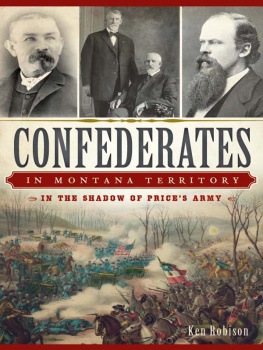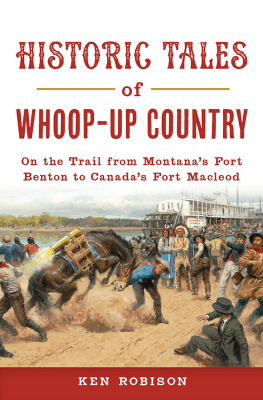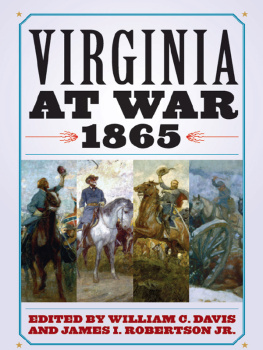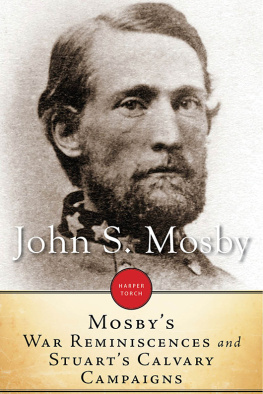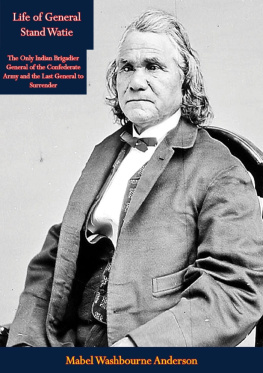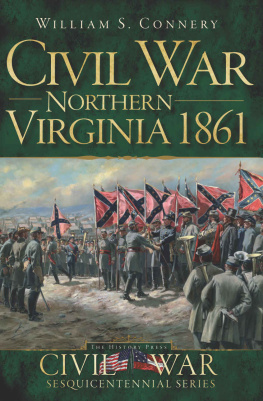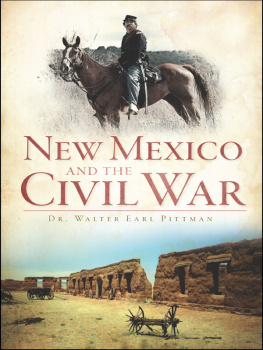
Published by The History Press
Charleston, SC 29403
www.historypress.net
Copyright 2014 by Ken Robison
All rights reserved
First published 2014
e-book edition 2014
ISBN 978.1.62585.138.3
Library of Congress Control Number: 2014952244
print edition ISBN 978.1.62619.603.2
Notice: The information in this book is true and complete to the best of our knowledge. It is offered without guarantee on the part of the author or The History Press. The author and The History Press disclaim all liability in connection with the use of this book.
All rights reserved. No part of this book may be reproduced or transmitted in any form whatsoever without prior written permission from the publisher except in the case of brief quotations embodied in critical articles and reviews.
Many histories of the Civil War record the exploits of the big guys. Heres to the gray and the blue; the men, women and children from South and North who came to Montana Territory to find shelter, hope and opportunity; and the modern generations who treasure their past.
CONTENTS
FOREWORD
From Texas to Maine, from Minnesota to Florida, the nation engaged in an epic struggle of the War Between the States, the Civil War. The West, including the territory of Montana, has often been described as the relief valve for the great pressure cooker of the Civil War. Certainly the discovery of gold had a great deal to do with the sudden rush of people to the region, and the order or disorder of politics was to keep pace with this influx.
Territorial appointments such as first governor Sidney Edgerton were naturally Republican, and this generated a small but very active and vocal Republican presence in the territory. Another important component was that of the Union or War Democrats. But it was the third group that was to have the most profound effect on politics in the new territory. Southern Democrats had come into the territory in large numbers.
For years, historians have focused on this influx of Southern Democrats in Montana Territory and have pondered the reasons why they came in such large numbers. In a five-month period, from December 24, 1860, to May 21, 1861, eleven states left the Union to create the Confederate States of America. While this drama was playing itself out, the Lincoln administration was pulling out all stops in an effort to keep the border states of Maryland, Kentucky and Missouri in the Union. If the future had been left in the hands of their population, there is little doubt that these states would have followed their brethren into the new confederation. They were kept in the Union by military force. We know that of the three, Lincoln saw Missouri as the lynch pin. There was bitter fighting in Missouri in both the early and late stages of the war, and this led to the displacement of large numbers of people.
In July 1861, in the immediate aftermath of the Federal defeat at First Manassas (First Bull Run), President Lincoln ordered that Union forces in the wars western theater go on the offensive, giving special attention to Missouri.
If one looks at a map of the country, it is evident why the state of Missouri was to be such a focus for either the preservation of the Union or the establishment of the Confederacy. All major trails that led to the West started in Missourithe California Trail, the Oregon Trail and Santa Fe Trail. California had been admitted to the Union in 1859 and was surrounded by territories. There was a real and legitimate fear that it could be cut off and isolated with the loss of Missouri. Other factors that made the state so important were the tremendous gold strikes in far-off Idaho Territory, soon to become Montana Territory, plus the fact that all three of the major riversthe Mississippi, the Missouri and the Ohiocritically important shipping arteries, went through or bordered the state. Control of the Mississippi River was strategically, economically and psychologically vital to both sides.
The first U.S. census of Montana Territory did not occur until 1870, by which time a major shift in the population had already taken place and certainly the population was in decline. In 1870, the total population of the territory was placed at 20,595, while it is likely that in the period 186466, the population might have hovered close to 30,000 centered in the gold camps. That Missouri contributed a significant number to that population is without doubt, although it is impossible to give an exact number. And these Missourians reflected a large number of the Southern Democrats to be found in the territory.
It has often been said that Missouri was kept in the Union on the point of Federal bayonets and that the extraordinary wartime powers of the Lincoln administration were well reflected there. With the suspension of the writ of habeas corpus, an untold number of pro-secession Missourians were simply detained as virtual prisoners of war and, when released, ordered out of the state, instructed to proceed to a western territory and remain there for the duration of the conflict. Another factor was the soldiers who had been captured, released and then exiled from the state with the same understanding that they not return until wars end. This situation was reflected in the population trend in Montana Territory; in the immediate aftermath of the war, many did return to their homes, while others did not. This mixture of exiled and displaced Missourians, civilians as well as former Confederate soldiers added to the mix of Southern Democrats found in Montana Territory.
The impact of the proud and strong Southern people in the territorial days of Montana was a true reflection of the Southern character. Never give up. Never give in. It has been said that politically the Southern people have known nothing but defeat, and in many respects, this is true. But what is far more important is that the Southerner always comes back and rises to fight again. Never give up. Never give in.
Richard L. Thoroughman
Sons of Confederate Veterans

Map of Montana from Fort Benton to the gold mining camps of Bannack and Virginia City, 1865. Authors collection.
ACKNOWLEDGEMENTS
The response around Montana and the nation to my first Civil War book, Montana Territory and the Civil War: A Frontier Forged on the Battlefield, has been exciting. Much interest stems from the 150th anniversary of the Civil War and from the celebration of the creation of Montana Territory on May 26, 1864. Perhaps more interest comes from Montanans who have Civil War ancestors, many having inherited treasures from their Yankee or Rebel heritage.
From Missoula to Sidney, from Great Falls and Helena to Billings, libraries, bookstores and other venues have welcomed me to hold conversations and signings. Montanas independent booksellers like Fact and Fiction and Montana Book Company, though all too few, are treasures in our communities. To all booksellers, remember that eBooks are fun, but real books are keepsakes! Who has heard of a prized possession first-edition eBook?
To descendants of those who served in the Civil War who have protected and shared the diaries, letters, papers and artifacts handed down to them, exemplified by the Raymond HowardCharlene Nava family, my admiration. To those active in reenactment groups, like Colonel Thomas Huether and his 1st U.S. Volunteer Infantry (the famed Galvanized Yankees), Tiea Toby (Clara Barton) and Jim Vaughn, keep up your great work. For encouragement and research assistance throughout, a special thanks to friend Dick Thoroughman of Fort Shaw, a descendant of Confederates Oliver H.P. Thoroughman and Colonel Thomas Thoroughman. To Jay Hoar, my admiration for your knowledge of Civil War veterans, North and South. And to dear Kay Strombo of the Mineral County Museum, who shared her research of more than 6,200 Montana Civil War veterans.
Next page
